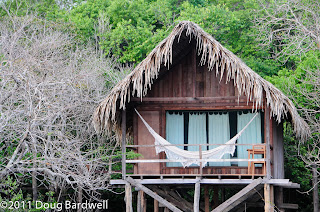 |
| Scottevest with sleeves and hood removed. |
Did you ever have a love affair with a piece of clothing? I did. It was a
rain coat I bought to take to Alaska back in 1997. Somehow, after just 12 short
years, it died. Started peeling apart at the seams. Time to find a replacement.
What I loved about it was its light weight, breathability and real
waterproofness. Not water-repellant as so many coats advertise. It was
waterproof, snow proof, ice proof...well, you get the idea.
So the search was on. I looked at many
different coats earlier this year while at the Travel Goods Show in Chicago and
subsequently at numerous outdoor recreation stores since then. With all the
electronic and camera gear I carry, there was only one logical choice as a
worthy successor to my old love and that was a new Scottevest RevolutionJacket.
More than just a rain jacket, this also has zip-off sleeves and a hidden
and removable hood. I really need a hood for a year-round jacket. When removed, the sleeves and hood can be stored
in one of the many pockets.
The material is a breathable Teflon coated material with hot melt
lamination for the ultimate in water-proofing. With great vapor-permeability,
it is suitable for use in all climes, but more on that later.
Scottevest has been known for years as the company that has pockets for
everything and yet somehow you can wear their clothes loaded with gear and not
look like a walking sack of oranges. Each pocket is engineered to hold various
gadgets close to your body without creating large bulges in the jacket
fabric. I don't know how they do it, but
they pull it off better than anyone else on the market.
 |
| Shooting flamingos in the salt flats |
And did I mention they make pockets for everything? No, seriously, I mean
it. The Revolution has 26 pockets plus a personal area network (PAN) system
that conceals the wiring for your headphones.
That means your ear buds just stay right in the jacket, ready to be used
at any time, or tucked away in their own special slots when you aren't using
them. No more screwed-up cords waiting
to be untangled.
So let's talk about the pockets for a minute. Where I really got a kick out
of this coat was going through airport security. On a recent trip to Chile, I
visited four different areas of the country and I was on and off planes 10
times in 12 days.
Before Scottevest, I would carry some things in my coat, some in my shirt
pockets and some in my pants pockets.
With the new airport scanners, you can't leave as much as a piece of
paper in your shirt or pants. So here's where it starts to get good with the
Revolution. Everything, and I mean everything, goes into my jacket.
Interior see-thru pockets let me keep my iPhone on my left and my classic
iPod on the right. Both can be played without removing them from their pockets.
A pen and pencil fit neatly into a slot pocket parallel to the zipper on one
side and a magic marker and highlighter fit in the slot on the opposite side.
Right below my iPhone, a wide pocket perfectly holds boarding passes and
passport. Another see-thru pocket below that holds a driver’s license and
flight club membership cards.
A larger pocket behind those actually holds an iPad or in my case, a
netbook computer. How cool is that? Now I can use that second carry-on for my
large DSLR camera, since my computer is tucked in my coat and doesn't count
when I go past the airline ticket takers.
 |
| Walking my llama in the Atacama desert |
Remember me mentioning that the pockets don't bulge? That even goes for the
computer/iPad pocket. It’s almost unperceivable
that I'm carrying it. And, the PAN system even extends down into this pocket so
if I wanted to listen to music from an iPad, I could do that as well. If you
aren't carrying an iPad, it makes a perfect magazine or newspaper pocket.
Inside the coat on the other side is a side-opening pocket for sunglasses,
complete with a cleaning cloth on an elastic cord. I'm always getting
fingerprints on my glasses as I shoot photographs so the cleaning cloth is
always a handy thing to carry.
Right below that I carry my small point and shoot Canon S90 digital camera
and extra batteries and memory cards. More times than I can mention, I've been
so happy I was carrying a high quality digital camera when the perfect,
unexpected photo-op arose.
Moving to the outside of the jacket, there are six more major pockets. Two
are high on the chest and I use these for a digital recorder and a notebook,
used for impromptu interviews or recording tour guides.
Down lower, in typical jacket placement there are two more pockets on each
side, both with zippers to keep everything inside. Inside the outer pockets,
there is another Velcro pocket for loose change on one side and an extendable
key holder in the other. The right pocket also has an internal stretch loop
that secures a typical bottle of water inside the jacket. I did mention that it
held everything didn't I?
 |
| A mini blizzard prevented us from climbing Villarica |
Two remaining pockets outside can hold snacks, your computer charger,
wireless mouse or digital card readers. I used one of these two to store my
sleeves and hood when converting this to a vest.
As I mentioned, I hit four different areas of Chile, from the Altaplano
high desert in the north all the way down to Pucon in the southern Lake
District. With the sleeves and hood off,
it functioned as a vest I could wear comfortably out in the desert, ready for later
in the evening when the temperature would drop 40 degrees.
In Valparaiso, the fog hung like a puffy comforter over the entire seafront
the night we arrived. Walking the
sidewalks along the break wall, the waves were crashing over the railing, and
it was great to have a real waterproof raincoat that protected my electronics
inside.
Down south in Pucon, as I rode the ski lift in a mini-blizzard, I was glad
that hood was ready to pop-out and keep my hair-challenged head nice and toasty
warm. Chile is a beautiful country and
the extremes of its climates gave me a year's worth of testing in just two
weeks.
So, did I get over my old love affair and so quickly start a new one? Well, I can't remember my old coat's name
anymore so I guess I did. Scottevest, where have you been all my life? It's
great to get to know you. Want to go to Taiwan next month?























